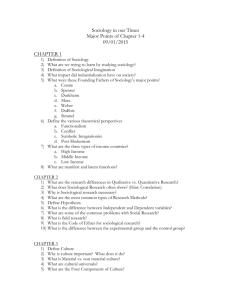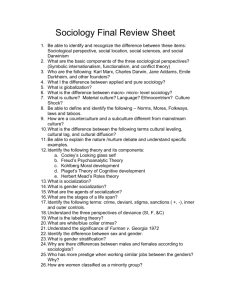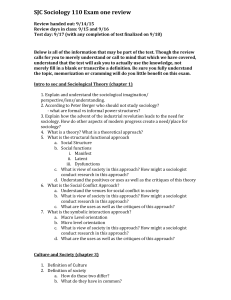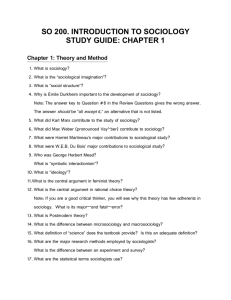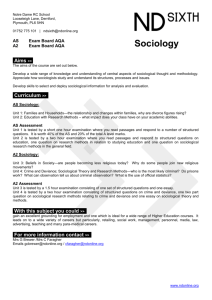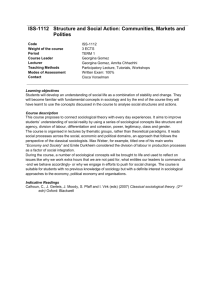Introduction To Sociology SOC-101-TE
advertisement
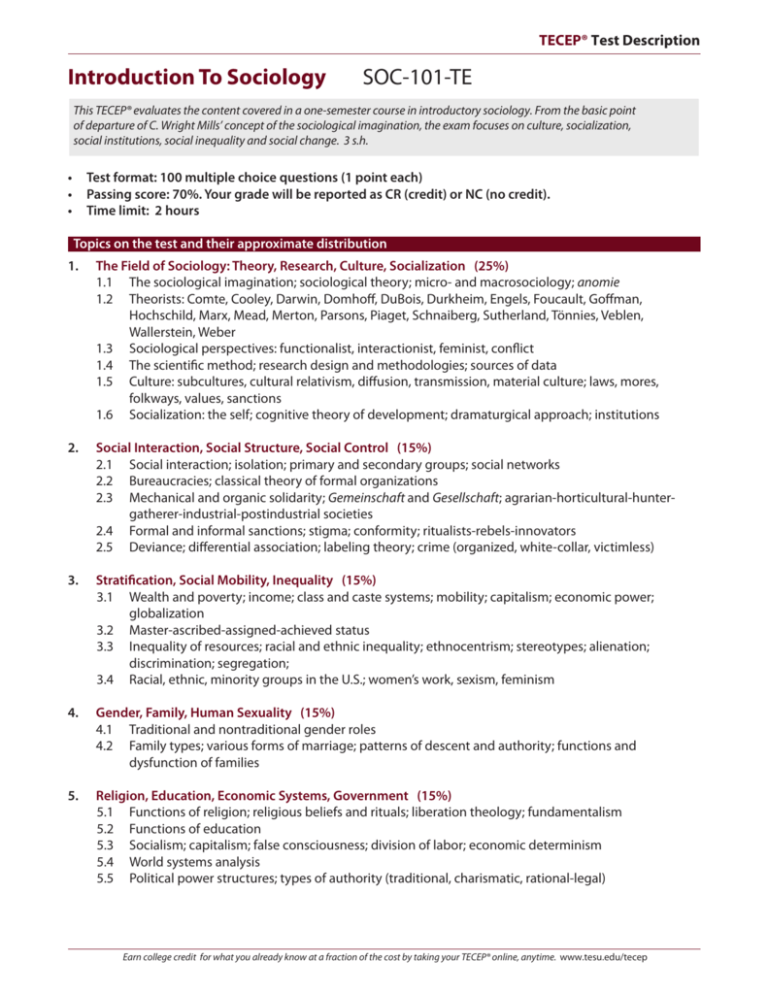
TECEP® Test Description Introduction To Sociology SOC-101-TE This TECEP® evaluates the content covered in a one-semester course in introductory sociology. From the basic point of departure of C. Wright Mills’ concept of the sociological imagination, the exam focuses on culture, socialization, social institutions, social inequality and social change. 3 s.h. • • • Test format: 100 multiple choice questions (1 point each) Passing score: 70%. Your grade will be reported as CR (credit) or NC (no credit). Time limit: 2 hours Topics on the test and their approximate distribution 1. The Field of Sociology: Theory, Research, Culture, Socialization (25%) 1.1 The sociological imagination; sociological theory; micro- and macrosociology; anomie 1.2 Theorists: Comte, Cooley, Darwin, Domhoff, DuBois, Durkheim, Engels, Foucault, Goffman, Hochschild, Marx, Mead, Merton, Parsons, Piaget, Schnaiberg, Sutherland, Tönnies, Veblen, Wallerstein, Weber 1.3 Sociological perspectives: functionalist, interactionist, feminist, conflict 1.4 The scientific method; research design and methodologies; sources of data 1.5 Culture: subcultures, cultural relativism, diffusion, transmission, material culture; laws, mores, folkways, values, sanctions 1.6 Socialization: the self; cognitive theory of development; dramaturgical approach; institutions 2. Social Interaction, Social Structure, Social Control (15%) 2.1 Social interaction; isolation; primary and secondary groups; social networks 2.2 Bureaucracies; classical theory of formal organizations 2.3 Mechanical and organic solidarity; Gemeinschaft and Gesellschaft; agrarian-horticultural-hunter- gatherer-industrial-postindustrial societies 2.4 Formal and informal sanctions; stigma; conformity; ritualists-rebels-innovators 2.5 Deviance; differential association; labeling theory; crime (organized, white-collar, victimless) 3. Stratification, Social Mobility, Inequality (15%) 3.1 Wealth and poverty; income; class and caste systems; mobility; capitalism; economic power; globalization 3.2 Master-ascribed-assigned-achieved status 3.3 Inequality of resources; racial and ethnic inequality; ethnocentrism; stereotypes; alienation; discrimination; segregation; 3.4 Racial, ethnic, minority groups in the U.S.; women’s work, sexism, feminism 4. Gender, Family, Human Sexuality (15%) 4.1 Traditional and nontraditional gender roles 4.2 Family types; various forms of marriage; patterns of descent and authority; functions and dysfunction of families 5. Religion, Education, Economic Systems, Government (15%) 5.1 Functions of religion; religious beliefs and rituals; liberation theology; fundamentalism 5.2 Functions of education 5.3 Socialism; capitalism; false consciousness; division of labor; economic determinism 5.4 World systems analysis 5.5 Political power structures; types of authority (traditional, charismatic, rational-legal) Earn college credit for what you already know at a fraction of the cost by taking your TECEP® online, anytime. www.tesu.edu/tecep TECEP® Test Description 6. Health, Environment, Social Change (15%) 6.1 Medical model; perceptions of mental illness 6.2 Global climate change; pollution; NIMBY 6.3 Social change movements; rebellion and revolution; technology and culture lag; emigration Outcomes assessed on the test • Describe key concepts in the field of sociology (e.g. culture, socialization, deviance, etc.). • Apply the major sociological theories to social phenomena and events. • Examine the intersection of history and individuality and the distinctions between private troubles and public issues. • Identify the pros and cons of various sociological research methods in understanding social interactions. • Identify questions that generate sociological insights into contemporary social problems. • Explain the effect of culture on beliefs and behavior. • Analyze aspects of American and global culture. • Employ the sociological imagination as an intellectual tool for value dilemmas and critical decisions. Study materials Schaefer, Richard T. Sociology: A Brief Introduction. Current edition. New York: McGraw-Hill Education. Free online resources: Introduction to Sociology https://openstaxcollege.org/textbooks/introduction-to-sociology Sociology: Brief Edition v1.1 http://2012books.lardbucket.org/books/sociology-brief-edition-v1.1/ Sample questions 1. Which of the following best describes anomie? a. A hypothetical model that sociologists use to evaluate real-world cases b. A society’s loss of direction when social control of individual behavior is ineffective c. A research classification system including at least two categories d. A disorder similar to depression that frequently results in suicide 2. Which of the following is a manifest function of universities? a. To prepare people for professional careers b. To provide opportunities for people to find their future spouses c. To give students enough time to exercise d. To maintain the economic status quo 3. Researchers have found that married people are less likely to commit suicide than divorced people. In this example, suicide is a(n) a. index b. hypothesis c. dependent variable d. independent variable Earn college credit for what you already know at a fraction of the cost by taking your TECEP® online, anytime. www.tesu.edu/tecep TECEP® Test Description 4. Sam, an American, assumes that the American culture and way of life are the norm and superior to all others. This is an example of a. culture shock b. stereotyping c. ethnocentrism d. endogamy 5. Emily, age 8, is able to grasp her own social position as well as that of the people around her. She begins to consider several tasks and relationships simultaneously. According to George Herbert Mead’s theory, Emily is at the ________ stage. a. play b. game c. imitative d. preparatory 6. George is on a date with Pat. He tries to behave in a way that will make Pat like him and want to go out again. George is engaging in a. face-work b. instrumental deception c. ambassador socialization d. impression management 7. People who work at a specific task are more likely to become highly skilled and perform the job with maximum efficiency. This is the rationale for which of the following characteristics of a bureaucracy? a. Division of labor b. Hierarchy of authority c. Written rules and regulations d. Employment based on technical qualifications 8. Joe and Brynn are in the same Spanish class. During the final exam, Joe gets a perfect score by copying Brynn’s answers. According to Merton’s anomie theory of deviance, Joe is a(n) a. rebel b. ritualist c. innovator d. retreatist 9. The system by which groups of people are ranked in a society on the basis of power and economic wealth is known as a. status b. hypergamy c. social mobility d. stratification 10. According to world systems analysis, where are poor and developing nations found? a. On the periphery b. On the semiperiphery c. In external areas d. At the center Earn college credit for what you already know at a fraction of the cost by taking your TECEP® online, anytime. www.tesu.edu/tecep TECEP® Test Description 11. A negative attitude toward an entire category of people is known as a. prejudice b. racism c. exploitation d. discrimination 12. Juana, a Latina engineer, mentors Daniel, a young White engineer. According to the contact hypothesis, what might be the result of this scenario? a. It might facilitate the operation of sexism as well as racism. b. It might increase stereotypes rather than reduce them. c. It might encourage Juana to engage in color-blind racism. d. It might cause Juana and Daniel to become less prejudiced. 13. The ________ perspective had the most influence on the feminist perspective. a. global b. conflict c. functionalist d. interactionist 14. ________ descent is a kinship system that traces descent through the relatives of the mother. a. Bilineal b. Matrilineal c. Trilineal d. Patrilineal 15. Suzanne seeks to become friends with Thomas because he has connections to a career opportunity. This is an example of a. socialization b. bureaucracy c. expressiveness d. instrumentality 16. Smithville Church is a training ground for community leaders and helps its members improve their interpersonal skills. These are examples of the church’s a. manifest functions b. manifest dysfunctions c. latent functions d. latent dysfunctions 17. Which term refers to the use or threat of violence against random or symbolic targets in pursuit of political aims? a. Guerrilla warfare b. Terrorism c. Protest d. Politics 18. The study of the interrelationships among people in their spatial setting and physical environment is known as a. environmental psychology b. human ecology c. epidemiology d. anthropology Earn college credit for what you already know at a fraction of the cost by taking your TECEP® online, anytime. www.tesu.edu/tecep TECEP® Test Description 19. According to ________ theory, African and South American countries will change by moving in the same direction as Western societies. a. evolutionary b. Eurocentric c. world systems d. resource development 20. A society that moves from having high birth and death rates to having low birth and death rates has experienced ________ transition. a. economic b. population c. agricultural d. demographic Answers to sample questions 1. b 2. a 3. c 4. c 5. b 6. d 7. a 8. c 9. d 10. a 11. a 12. d 13. b 14. b 15. d 16. c 17. b 18. b 19. a 20. d Earn college credit for what you already know at a fraction of the cost by taking your TECEP® online, anytime. www.tesu.edu/tecep

